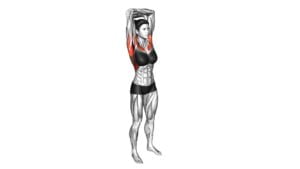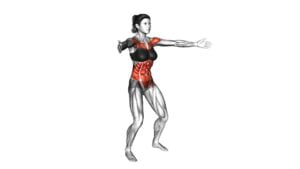Standing Shoulders Full Flexion (male) – Video Exercise Guide & Tips

Looking to improve your shoulder flexibility? Check out this video exercise guide and tips for Standing Shoulders Full Flexion.
Watch This Exercise Video
In this guide, you'll learn about the benefits of this exercise, proper form and technique, common mistakes to avoid, and tips to increase your shoulder flexibility.
Whether you're a beginner or an advanced user, this guide has variations and progressions to suit your level.
Get ready to enhance your shoulder mobility and improve your overall fitness.
Let's get started!
Key Takeaways
- Improved posture
- Increased range of motion in the shoulders
- Prevention and reduction of shoulder injuries
- Strengthening of upper back, shoulders, and chest muscles
Benefits of Standing Shoulders Full Flexion
- You'll experience three key benefits from practicing standing shoulders full flexion. First and foremost, this exercise promotes improved posture. By regularly engaging in standing shoulders full flexion, you strengthen the muscles in your upper back, shoulders, and chest, which helps to align your spine and pull your shoulders back. This can help alleviate the strain that comes from slouching and sitting for extended periods.
Additionally, this exercise increases your range of motion in the shoulders. As you consistently work on the full flexion of your shoulders, you gradually increase their flexibility, allowing you to move your arms and shoulders more freely and with less discomfort.
Lastly, standing shoulders full flexion helps to prevent and reduce the risk of shoulder injuries. By strengthening the surrounding muscles and improving flexibility, you enhance the stability and support of your shoulders, making them less susceptible to strains, sprains, and other injuries.
Incorporating this exercise into your routine can have a profound impact on your overall posture, mobility, and shoulder health.
Proper Form and Technique for the Exercise
To perform the standing shoulders full flexion exercise correctly, you should focus on maintaining proper form and technique throughout the movement. This won't only help you maximize the benefits of the exercise but also prevent any potential injuries.
Here are three important tips to keep in mind:
- Start with good shoulder mobility: Before attempting the exercise, it's crucial to ensure that your shoulders have sufficient mobility. This can be achieved through regular stretching techniques such as shoulder circles, arm swings, and wall stretches. Improving shoulder mobility will enable you to perform the exercise with a greater range of motion and reduce the risk of strain.
- Engage your core and maintain stability: Throughout the exercise, it's important to engage your core muscles and maintain stability. This will help you maintain proper alignment and prevent unnecessary strain on your back and shoulders. Focus on keeping your spine neutral and your abdominals tight throughout the movement.
- Control the movement and avoid excessive weight: When performing the standing shoulders full flexion exercise, it's essential to control the movement and avoid using excessive weight. Start with a weight that allows you to maintain proper form and technique. Gradually increase the weight as your strength and shoulder mobility improve, but always prioritize maintaining proper form over lifting heavy weights.
Common Mistakes to Avoid
Avoiding common mistakes is crucial when performing the standing shoulders full flexion exercise. By understanding and avoiding these mistakes, you can reduce the risk of injuries and maximize the effectiveness of the exercise.
One common mistake to avoid is neglecting the importance of a proper warm-up. Before starting the standing shoulders full flexion exercise, it's essential to warm up your shoulder joints and muscles to increase blood flow and flexibility. This can be done through simple dynamic stretches and mobility exercises.
Another mistake to avoid is using excessive weight. It's important to start with a weight that's manageable and gradually increase it over time. Using too much weight can lead to poor form and potential injuries. It's also crucial to maintain proper form throughout the exercise. Avoid swinging or using momentum to lift the weight, as this puts unnecessary strain on your shoulder joints and reduces the effectiveness of the exercise.
Lastly, rushing through the exercise or performing it with improper technique can lead to injuries. Take your time and focus on performing each repetition with control and precision. If you're unsure about the correct form, it's recommended to consult a fitness professional or watch instructional videos to ensure you're performing the exercise correctly.
Tips to Increase Shoulder Flexibility
To increase shoulder flexibility, focus on incorporating specific stretches and exercises into your routine. Here are three tips to help you improve your shoulder mobility:
- Shoulder Stretches: Incorporate stretches that target the muscles surrounding the shoulder joint. Examples include the cross-body shoulder stretch, where you pull one arm across your chest and hold for 30 seconds on each side, and the shoulder extension stretch, where you interlock your fingers behind your back and gently lift your arms upward. These stretches can help increase the range of motion in your shoulders and improve flexibility.
- Shoulder Mobility Exercises: Perform exercises that promote shoulder mobility, such as shoulder circles and wall slides. Shoulder circles involve standing with your arms by your sides and making circular motions with your shoulders, gradually increasing the size of the circles. Wall slides require you to stand against a wall with your arms bent at 90 degrees, then slowly slide your arms up and down the wall while maintaining contact with your back and arms. These exercises help to strengthen the muscles around the shoulder joint and improve flexibility.
- Consistency is Key: Make sure to consistently incorporate shoulder stretches and mobility exercises into your routine. Regular practice will help maintain and improve shoulder flexibility over time. Aim to perform these exercises at least two to three times per week for optimal results.
Remember to listen to your body and avoid pushing beyond your limits. If you experience any pain or discomfort during these exercises, consult a healthcare professional for guidance.
Variations and Progressions for Advanced Users
For advanced users, try incorporating more challenging variations and progressions to further enhance your shoulder flexibility. By introducing variations into your shoulder flexion exercises, you can target different muscles and add an element of surprise to your workout routine.
One variation you can try is the seated shoulder flexion exercise. Instead of standing, sit on a bench or chair and perform the exercise. This will engage your core and challenge your balance while still targeting your shoulder flexibility.
Another variation to consider is the use of resistance bands. Attach a resistance band to a sturdy object and hold the other end in your hand. As you perform the shoulder flexion exercise, the resistance from the band will provide an additional challenge and help strengthen your shoulder muscles.
If you're looking for even more challenges, you can progress to more advanced exercises such as the handstand push-up. This exercise requires a high level of shoulder strength and flexibility, as well as core stability. Start by practicing against a wall and gradually work your way up to performing a freestanding handstand push-up.
Remember to always listen to your body and progress at your own pace. It's important to challenge yourself, but also to prioritize safety and proper form.
Frequently Asked Questions
How Often Should I Perform the Standing Shoulders Full Flexion Exercise?
To improve your shoulder flexibility, it's important to incorporate exercises like the standing shoulders full flexion into your routine. This exercise helps strengthen and stretch your shoulder muscles, enhancing your overall range of motion.
It's recommended to perform this exercise at least 2-3 times a week for optimal results. By regularly engaging in shoulder exercises, you'll experience improved posture, increased mobility, and reduced risk of shoulder injuries.
Can I Perform This Exercise if I Have a Shoulder Injury?
If you have a shoulder injury, it's important to modify the standing shoulders full flexion exercise. Consult with a healthcare professional or a qualified trainer for specific modifications that suit your condition.
While this exercise can be beneficial for strengthening the shoulder muscles and improving flexibility, it may not be suitable for everyone with a shoulder injury. Modify the exercise to avoid any pain or discomfort and focus on rehabilitation exercises recommended by your healthcare provider.
Is It Normal to Feel Discomfort or Pain During This Exercise?
During the exercise, it isn't uncommon to experience some discomfort or pain in your shoulders. However, it's important to listen to your body and not push through any sharp or intense pain.
If you're experiencing consistent discomfort, it might be beneficial to consult with a healthcare professional or a certified trainer who can assess your shoulder mobility and suggest exercise modifications that can help alleviate the discomfort.
Can Standing Shoulders Full Flexion Help Improve My Posture?
Standing shoulders full flexion can definitely help improve your posture. Proper posture plays a crucial role in reducing musculoskeletal pain and maintaining overall fitness. By engaging the muscles of your shoulders and upper back, this exercise helps strengthen and stabilize those areas, leading to better alignment and posture.
Additionally, improved posture can enhance your athletic performance and prevent injuries. So incorporating standing shoulders full flexion into your fitness routine can have numerous benefits for your overall well-being.
Are There Any Modifications I Can Make to This Exercise if I Have Limited Shoulder Mobility?
If you have limited shoulder mobility, there are modifications you can make to the standing shoulders full flexion exercise. For example, you can use a resistance band or towel to assist in the movement and gradually increase the range of motion.
This exercise is beneficial for shoulder health as it helps improve flexibility and strength in the shoulder muscles. It can also help improve posture by promoting better alignment of the shoulders.
Conclusion
In conclusion, standing shoulders full flexion is a beneficial exercise for increasing shoulder flexibility. By maintaining proper form and avoiding common mistakes, you can effectively target your shoulder muscles.
To further enhance your shoulder flexibility, try incorporating variations and progressions into your routine. Remember to always listen to your body and consult with a professional if you have any concerns or limitations.
With consistent practice and proper technique, you can improve your shoulder mobility and enhance your overall fitness.

Author
Years ago, the spark of my life’s passion ignited in my mind the moment I stepped into the local gym for the first time. The inaugural bead of perspiration, the initial endeavor, the very first surge of endorphins, and a sense of pride that washed over me post-workout marked the beginning of my deep-seated interest in strength sports, fitness, and sports nutrition. This very curiosity blossomed rapidly into a profound fascination, propelling me to earn a Master’s degree in Physical Education from the Academy of Physical Education in Krakow, followed by a Sports Manager diploma from the Jagiellonian University. My journey of growth led me to gain more specialized qualifications, such as being a certified personal trainer with a focus on sports dietetics, a lifeguard, and an instructor for wellness and corrective gymnastics. Theoretical knowledge paired seamlessly with practical experience, reinforcing my belief that the transformation of individuals under my guidance was also a reflection of my personal growth. This belief holds true even today. Each day, I strive to push the boundaries and explore new realms. These realms gently elevate me to greater heights. The unique combination of passion for my field and the continuous quest for growth fuels my drive to break new ground.







